
|
|
|
|
|
|
|
|
|
|
|
|
|
(1987) Director: Lewis
Teague
It's inevitable that, with The Unknown Movies
being
bigger and better than ever, I'll soon be awash with fame and fortune.
And with At that note, I'll lean back and point a finger at Leno, saying, "Jay, I have two words to say to you: 'Collision' and 'Course'." Then Leno will hastily cut to a commercial, as I treat myself to a big grin while the studio audience makes an "Ooooooooooooooooh" noise. Come to think of it, it probably won't happen - the
"Ooooooooooooooooh"
bit, that is. That's because even you probably haven't heard of Collision
Course, which has Jay Leno as the second-billed star. Why
haven't
you heard about it? Well, the Collision Course starts with the sound of
a car crash - another bad sign that should be seriously considered by
those
foolish enough to have rented it. Then a few minutes later, we get a
near
miss of a warning, because it soon becomes apparent that this movie is
going to do the same thing as Red Heat, putting together
two mismatched cops. (This would have gotten the movie the label of a
tired
rip-off, had it not been actually made before Red Heat.)
And of course, the goofy and not-by-the-book cop, the first of the Seeing Leno so bad here, it's hard to believe he's shown humor and likeability elsewhere. It's the same with Morita; though you may remember him for a number of serious roles, he actually got his start in stand-up comedy and had a number of bit parts in comedies before he hit it big in The Karate Kid. Here he plays Tokyo detective Fuji Natsuo, who is ordered by his superior to track down a Japanese engineer who stole a top secret turbocharger prototype and fled to Detroit. Let's just say that Morita managed to generate more warmth and laughs as Mr. Miyagi than this character, though it's not really his fault. The script makes him a "Rotsa ruck" Japanese stereotype, where the times that his character says something that's supposed to be funny (and there aren't that many times) coming out from mispronouncing the English language or ludicrously misjudging American culture. More attempts to get laughs from this character come from the reactions of other people encountering him, one example being when Tony angrily blurts out to Fuji, "I ought to stir-fry your face!" That's actually one of the more minor instances of
racism
this movie has to offer. But getting back to the inevitable partnership
of Tony and Fuji, the movie makes some other serious faux pas here.
First
of all, the movie waits until about forty percent of the There is, in fact, a constantly nasty tone bubbling underneath the movie throughout. The Japan-bashing in this movie comes in all forms, like when a cop finds a dead Japanese and wonders out loud, "Can you call a Jap a John Doe?" (That slur "Jap", by the way, gets a real workout in this movie.) Also, there are several heavy-handed violent sequences in the movie that severely clash with the rest of the movie, and are so out of place, they seem like they were edited in from a completely different movie. Maybe they weren't, but some blame can still fall on the editor. If anyone can make sense of the struggle during the bad guys' restaurant lunch... or figure out what Fuji and Tony did between picking up photographs in the morning and breaking into the car factory at night... or how Fuji got access to a safe house for he and Tony to hide in despite being a complete stranger to Detroit, please send me an e-mail. Your reward will be knowing that you figured out something I couldn't, even after a lot of thought. It looks like director Lewis Teague more or less
abandoned
any effort to try to save this movie with either the script or the
actors,
because there is no sign that there's any effort to even try and
present
all this bad material in a superior light. The only sign that he was
trying
to make anything about the movie look good is in the locations. Though
the indoor locations (filmed on sets at the De Laurentiis studios) look
quite shabby, I was impres UPDATE: Greg Laughlin sent this along: "Hello. I just came across your website and enjoyed the write-ups on the many obscure movies listed on your menu. I worked for DEG (DeLaurentiis Entertainment Group) during its brief life and have some additional information on the production of Collision Course. It was filled with problems from the start. First, the film was rushed into production just before the potential DGA strike of 1987 (which was averted at the last minute). Morita, just off the success of the Karate Kid sequel, was holding out for $2 million which was a pretty sum at that time. Unfortunately, Gary DeVore (screenwriter and head of production) panicked and gave into the demand. Second, Leno had it written into his contract that he would be allowed to keep his tour schedule which meant production had to shut down by a particular time each day to accommodate Leno's club dates. He would fly from Wilmington, NC to the city he was performing and then fly back. Third, five directors in all worked on the production. If memory serves me right, it was John Guillermin, Bob Clark, Richard Flesicher and I forget the fourth director before Lewis Teague finished the film. It was chaotic to say the least and it showed in the final product. Keep up the good work." UPDATE 2: Michael Prymula e-mailed me with this: "Hey, you mentioned that you'd like to see Leno's opinion of this film or something like that? Well as a matter of fact, on an episode of The Tonight Show in December 2005, Steve Martin appeared on the show and there was a game called "name that clip" being played. Leno was supposed differentiate clips from Martin's films - Cheaper By The Dozen 2 and Shopgirl, but the last clip was from Collision Course, which Leno immediately said was a horrible movie. Martin said Leno was right, but that he still had to pay 20 dollars for making it! Pretty funny eh? Even though I'll admit to liking Collision Course myself though."
Check for availability on Amazon (VHS) See also: The In-Laws, Keaton's Cop, Real Men |
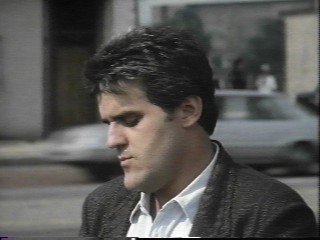 that will come invitations to
appear on various TV talk shows,
all of which I will be happy to accept (with the exception of Open
Mike
With Mike Bullard.) When I appear on The Tonight Show, I am
sure something like the following will happen: Jay Leno, after
determining
it's time to make the standard little dig at his guest, will say
something like, "So,
you're from Canada, eh? You actually live in the land where you say
they
make a lot of the bad movies that you review, hmmm?"
that will come invitations to
appear on various TV talk shows,
all of which I will be happy to accept (with the exception of Open
Mike
With Mike Bullard.) When I appear on The Tonight Show, I am
sure something like the following will happen: Jay Leno, after
determining
it's time to make the standard little dig at his guest, will say
something like, "So,
you're from Canada, eh? You actually live in the land where you say
they
make a lot of the bad movies that you review, hmmm?"
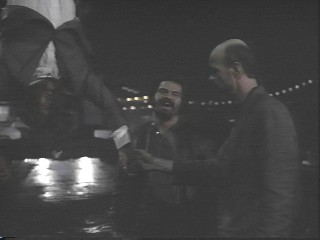 main reason is
because of the woes of its
theatrical distributor, De Laurentiis Entertainment. They were all set
to release it to theaters back in 1987, when their sudden bankruptcy
put
them and the movie in legal limbo. Five years later after the dust
settled,
they had managed to give out their other shelved movies (like Rampage)
to other theatrical distributors, but they couldn't find one for this
movie.
A very bad sign, one that can easily be confirmed by going to your
video
store, where you'll see it was dumped directly onto video. If you're
wise,
that's the furthest you will go in regards to this movie.
main reason is
because of the woes of its
theatrical distributor, De Laurentiis Entertainment. They were all set
to release it to theaters back in 1987, when their sudden bankruptcy
put
them and the movie in legal limbo. Five years later after the dust
settled,
they had managed to give out their other shelved movies (like Rampage)
to other theatrical distributors, but they couldn't find one for this
movie.
A very bad sign, one that can easily be confirmed by going to your
video
store, where you'll see it was dumped directly onto video. If you're
wise,
that's the furthest you will go in regards to this movie.
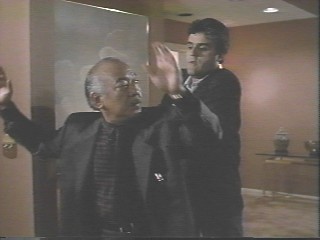 two
cops we meet, is naturally the American cop. In his introduction, we
see
detective Tony Costas (Leno) challenging a fellow motorist for a drag
race.
When a squad car pulls him over not long after the race began, he yells
at the rookie cops that they spoiled his undercover operation, and
would
the female cop please give him her phone number so he could question
her
later? Not only is all of this unfunny, but it gives us our first
bitter
taste of Leno's performance. To put it kindly, he's awful; he's not
only
unfunny and gives his character a very annoying personality, he's not
believable
as a cop. He lacks a hard edge, and treats the job as a joke, like he's
the goofball nephew working for his uncle's company. It says a lot that
James Belushi managed to be much more convincing as a cop in not only Red
Heat, but K-9.
two
cops we meet, is naturally the American cop. In his introduction, we
see
detective Tony Costas (Leno) challenging a fellow motorist for a drag
race.
When a squad car pulls him over not long after the race began, he yells
at the rookie cops that they spoiled his undercover operation, and
would
the female cop please give him her phone number so he could question
her
later? Not only is all of this unfunny, but it gives us our first
bitter
taste of Leno's performance. To put it kindly, he's awful; he's not
only
unfunny and gives his character a very annoying personality, he's not
believable
as a cop. He lacks a hard edge, and treats the job as a joke, like he's
the goofball nephew working for his uncle's company. It says a lot that
James Belushi managed to be much more convincing as a cop in not only Red
Heat, but K-9.
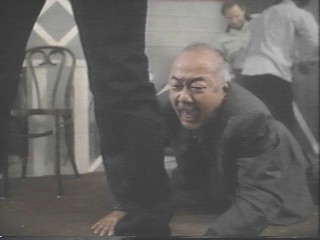 running time has
passed before the two actually partner up - before then, they just have
a few minor brushes that result in so little, you wonder why the movie
even had them pass each other in the first place. The second - and most
fatal - error is that when they are finally together, they have
absolutely
no chemistry together. Sure, they argue and fight a lot, but none of it
has any amusement or passion to it. All there seems to be in their
clashing
is hostility - even the quieter moments, when they are supposedly
getting
along, comes across like they are barely holding back from strangling
the
other.
running time has
passed before the two actually partner up - before then, they just have
a few minor brushes that result in so little, you wonder why the movie
even had them pass each other in the first place. The second - and most
fatal - error is that when they are finally together, they have
absolutely
no chemistry together. Sure, they argue and fight a lot, but none of it
has any amusement or passion to it. All there seems to be in their
clashing
is hostility - even the quieter moments, when they are supposedly
getting
along, comes across like they are barely holding back from strangling
the
other.
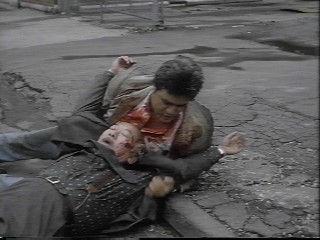 sed with the locations that were
actually shot
in Detroit itself. Unlike other movies that make Detroit look like a
cramped,
dirty, and unscrubbed New York City, more often than not we see a
Detroit
that reminded me a lot of the architecture in Vancouver. It's really
interesting
to see parts of this eastern metropolis that we have never seen before
in a movie. But although the locations are interesting, they and
everything
else in the movie has a strange look to it, as if this was lit and shot
by a television crew. It's a weird and uninviting feeling, and it's
just
another thing that makes it difficult to watch Collision Course.
At the end of the movie, you can see a now-expired offer by HBO Video
to
refund your money if you were unsatisfied with the movie. I'm surprised
this didn't result in HBO joining De Laurentiis in bankruptcy.
sed with the locations that were
actually shot
in Detroit itself. Unlike other movies that make Detroit look like a
cramped,
dirty, and unscrubbed New York City, more often than not we see a
Detroit
that reminded me a lot of the architecture in Vancouver. It's really
interesting
to see parts of this eastern metropolis that we have never seen before
in a movie. But although the locations are interesting, they and
everything
else in the movie has a strange look to it, as if this was lit and shot
by a television crew. It's a weird and uninviting feeling, and it's
just
another thing that makes it difficult to watch Collision Course.
At the end of the movie, you can see a now-expired offer by HBO Video
to
refund your money if you were unsatisfied with the movie. I'm surprised
this didn't result in HBO joining De Laurentiis in bankruptcy.